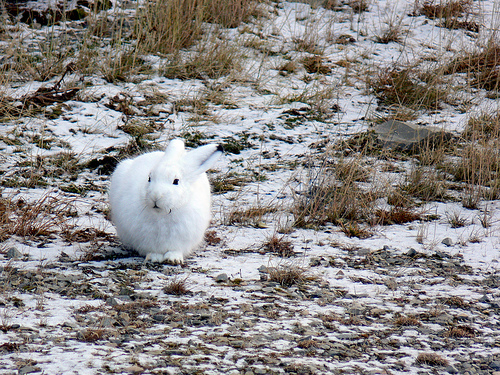Don’t lose your hair over the Arctic hare.
- Arctic hares are a species of hare native to the Arctic Circle, primarily in northern parts of Canada, Greenland, and islands of the Arctic.
- The scientific name of Arctic hares is Lepus arcticus and it is from the family Leporidae, the family of rabbits and hares.
- ‘Arctic hares’ are also known as ‘polar hares’ and ‘polar rabbits’, and they are said to be the largest species of hare in existence.
- Arctic hares generally range from 48 to 67 centimetres (19 to 26 inches) in length and weigh 2.5 to 5.5 kilograms (5.5 to 12.1 pounds), though they can be heavier.
- The diet of Arctic hares consists primarily of leaves from certain species of low growing plants, as well as twigs, roots, grass, moss and flowers depending on the season, while sometimes they are known to consume meat.
Arctic Hare
Image courtesy of Jodie Wilson/Flickr
- In winter, Arctic hares are generally white in colour to blend into their environment, and they become a blue-grey or brown-grey colour in the months without snow, so that they are more camouflaged in their habitat; however, hares in the northern regions, with short summers, may remain white or grey all year round.
- Female Arctic hares typically have two to eight young each year, during a period between April to September, and the young are generally able to fend for themselves after nine weeks.
- It is common for Arctic hares to live alone, however some gather in groups reaching hundreds of individuals; and they have an average lifespan of three to five years.
- Arctic hares can reach speeds of 64 kilometres per hour (40 miles per hour), achieving such speeds when threatened by predators like wolves, foxes, and large birds of prey; and they are also proficient swimmers and diggers.
- The Arctic hare has been hunted by humans for its meat, as well as its soft, thick and absorbent fur which is used for clothes, throughout much of North America’s history.
Bibliography:
Arctic Hare, 2016, A-Z Animals, http://a-z-animals.com/animals/arctic-hare/
Arctic Hare, 2016, National Geographic, http://animals.nationalgeographic.com.au/animals/mammals/arctic-hare/
Arctic Hare, 2016, Wikipedia, https://en.wikipedia.org/wiki/Arctic_hare
Lepus Arcticus, 2014, Animal Diversity Web, http://animaldiversity.org/accounts/Lepus_arcticus/







